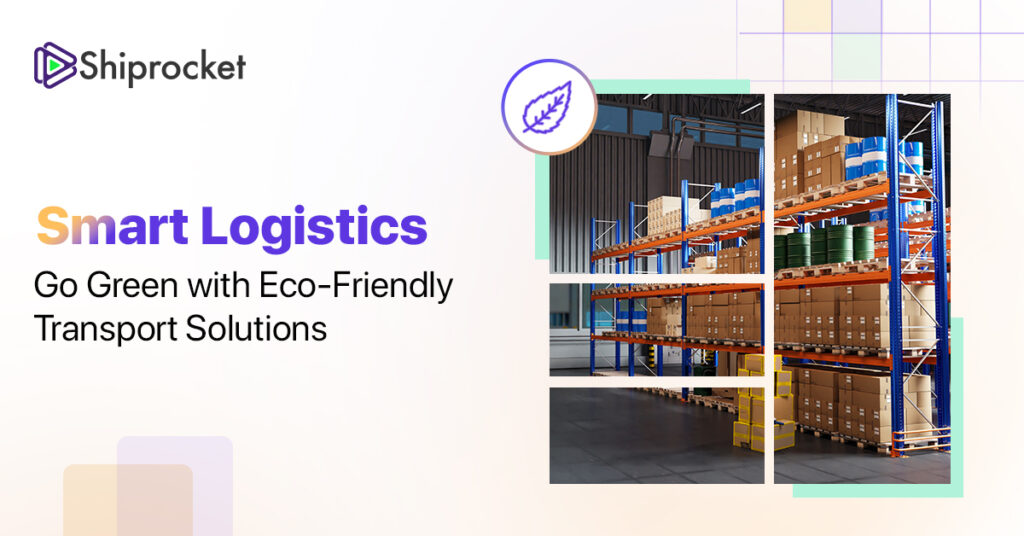Green Logistics: Eco-Conscious Transportation for Businesses!
- Green Logistics: An Overview
- Green Logistics: Aims and Obstacles to its Implementation
- The Benefits of Adopting Green Logistics Practices in Business
- Real-World Example of Green Logistics in Action
- Strategies for Effective Implementation of Green Logistics in Your Business
- Innovative Green Logistics Solutions: Alternative Distribution Models
- Envisioning the Future: Green Logistics in Distribution Networks
- Conclusion
Green logistics is a unique approach to transportation and supply chain management. It focuses on minimising the environmental impact of logistics activities while driving efficiency. As global awareness of climate issues grows, the demand for sustainability from consumers and stakeholders arises. Thus, more businesses are adopting eco-friendly logistics practises that reduce carbon emissions and offer competitive advantages.
From using renewable energy sources to adopting electric fleets and optimising routes, green logistics enables businesses to cut operational costs and contribute to a sustainable future. This blog will explore how transitioning to greener logistics can help reduce environmental pollution and innovate how transportation is managed in the long term.

Green Logistics: An Overview
Green logistics, also called sustainable logistics, is a business practice that aims to reduce the environmental impact of a company’s logistics, including warehousing, packaging, shipping, and delivery. The global market for green logistics services is expected to grow at a CAGR of 7.8% from 2024 to 2033, reaching a valuation of USD 2808.3 billion.
Green Logistics: Aims and Obstacles to its Implementation
The main objective of green logistics is to reduce greenhouse gas emissions by optimising various logistics operations:
- Minimise waste by optimising cargo space, reducing the number of trips required, reusing containers, and recycling packaging.
- Use lightweight, ergonomic, and plastic-free packaging materials and designs to reduce waste.
- Reduce air, soil, noise, and water pollution by analysing the impact of each logistics activity.
- Collecting orders in the same area and delivering them with only one vehicle, reducing the number of vehicles operating.
- Manufacture products and their packaging in a way that minimises their environmental impact.
- Adopt renewable energy sources and reduce the use of fossil fuels.
- Comply with environmental standards and regulations imposed by governmental bodies for both domestic and international trade.
However, green logistics faces several challenges in achieving these goals. Some of the major ones include.
- The transportation sector heavily depends on fossil fuels, and the worst part is that there is currently no economically viable alternative to this.
- The rise in quick commerce and eCommerce businesses has led to an increase in delivery vehicles in cities, but many of these are often underutilised.
- The initial investment in adopting sustainable practices in the logistics industry can be quite high. Moreover, the time and resources required to transform a business’s existing processes into green logistics can be expensive and may not receive the approval of top management.
- Some businesses could be reluctant to use new transportation methods that reduce emissions or use more expensive and eco-friendly materials. They may also be unable to invest in infrastructure, process automation, and more efficient handling equipment.
The Benefits of Adopting Green Logistics Practices in Business
Let’s look at the major advantages of adopting green logistical practices.
- The use of electronic vehicles, alternative fuels, and more optimised delivery routes helps lower carbon emissions. Energy management systems can also make storage spaces and warehouses more energy-efficient, reducing your business’s overall carbon footprint.
- You can reduce waste at every stage of the supply chain by recycling, optimising packaging, and reusing materials. You can also implement better waste disposal methods. Reducing waste means you can cut costs on material consumption and disposal of garbage.
- Businesses that adopt sustainable practices are more likely to outperform their competitors in the long run, both in terms of performance and the stock market.
- Sustainable packaging materials are often made from biodegradable or recycled materials, which are often cheaper than the ones traditionally used for packaging. This reduces your overall production costs.
Real-World Example of Green Logistics in Action
The eCommerce giant Amazon has taken several initiatives to reduce its carbon footprint and contribute towards environmental protection. It is reducing its reliance on air freight for international shipping and increasing the use of ocean freight to lower carbon intensity. It is also committed to using biofuels in shipping. Amazon is also conducting trials with battery-electric trucks and hydrogen-powered trucks for delivery. In Europe and India, it utilises EVs, e-cargo bikes, e-rickshaws, and opened micromobility hubs to deliver packages to customers sustainably.
Strategies for Effective Implementation of Green Logistics in Your Business
If your business is considering adopting green logistics, here are some tips that can help you do so more effectively.
1. Optimising Reverse Logistics
Reverse logistics refers to the managing of the orders your customers return. To minimise return rates, you can implement quality checks and ensure product descriptions are accurate. Robust reverse logistics strategies can help you reduce and manage order returns more efficiently. They can also help you move your business toward meeting your sustainability goals.
2. Creating Circular Supply Chains
A circular supply chain is one that uses materials, goods, etc., as long as possible, instead of immediately disposing of them as waste. It helps you reduce waste and increase sustainability by implementing recycling, reusing, and refurbishing materials and products. Creating circular supply chains can help your business cut costs, manage budgets, and reduce carbon footprints.
There are multiple ways businesses can create circular supply chains for green logistics.
- Make products that use fewer resources and can be used longer. They should be durable, easy to repair, recycle, and refurbish.
- Use biodegradable and recyclable materials to reduce the environmental impact.
- Reuse raw materials and resell previously owned goods.
3. Green Transportation: Use of Commercial EVs and Route Optimisation
Green transportation is any form of transportation that does not have a severe negative impact on the environment. It can be implemented in the following ways:
- Use electric or hybrid vehicles with alternative fuels, biofuels, or hydrogen to reduce carbon emissions.
- Use route planning and optimisation software to find the most efficient routes, reducing the distance travelled and thereby the emission.
- Pack goods into right-sized boxes to consolidate them and fit them into fewer vehicles. This will reduce the number of delivery vans operating on the road, reducing emissions.
- Enable your customers to choose when and where they want their products delivered. This will help reduce the chances of failed deliveries and the need to transport the consignment again.
4. Effective Recycling Practices
Recycling is an important part of green logistics, as it aims to reduce the amount of waste produced and its negative environmental impact. You can introduce robust recycling measures for sorting waste products. Once you start following the reuse, recycle, and reduce principles, you can significantly transform your logistics processes.
5. Warehouse Automation for Energy Efficiency
Warehouse automation goes a long way in ensuring energy efficiency and implementing green logistics. It can help you save time, money, and resources. You can reduce losses caused by the number of products that reach their expiry date. You can use energy-efficient technologies, smart lighting like LED lights, energy management software, and automated storage and retrieval systems (AS/RS). Streamlining inventory management, implementing climate control measures with HAVC systems, and upgrading to energy-saving equipment and machinery are other great ways that help implement green logistics.
6. Sustainable Sourcing of Materials
You can make sustainability an important factor in purchasing and procuring raw materials. Use renewable resources for manufacturing and recycled materials in packaging. Choosing materials like organic cotton, eco-friendly synthetics, and recycled fabrics can reduce carbon footprints compared to traditional fabrics. Using sustainable building materials for new facilities is also a key part of green logistics.
You should also be transparent and maintain visibility about sourcing practices, from procuring raw materials to manufacturing and delivery.
7. Tracking Carbon Footprints in Logistics: A Sustainable Approach
You can use advanced tools and software to measure, manage, and control emissions at every stage of the supply chain. Advanced technology for this specific purpose can help you identify areas for improvement and where you can reduce your environmental impact. It also helps you make informed decisions by leveraging data about routes, vehicle efficiency, fuel type, and more. Eventually, you can evaluate your current progress and improve operations.
Innovative Green Logistics Solutions: Alternative Distribution Models
Here are some alternative distribution models for green logistics.
- You can collaborate with other businesses by pooling shipments, sharing transportation resources, or using shared distribution centers.
- Unbranded parcel lockers can help you shorten delivery routes and speed up deliveries.
- Automated load optimisation to coordinate items with similar delivery destinations and estimated delivery times to maximise efficiency and reduce costs.
- Night-time delivery can help reduce the amount of time vehicles spend on the road due to less traffic and congestion, which can reduce the use of fuel and energy.
- On-demand micro-mobility networks use small vehicles like electric bikes and scooters for local deliveries.
- Use dynamic route allocation methods to assess traffic, parking and other factors that delay deliveries so that you can plan routes accordingly.
- You can minimise wasted space and maximise natural light when constructing new warehouses. You can also install solar photovoltaic roof panels or paint your roof a reflective colour to help keep your warehouse cooler.
Envisioning the Future: Green Logistics in Distribution Networks
Green logistics is becoming an important aspect for businesses as consumers and the world become more aware of environmental issues. In the future, it may see the use of cloud-based and AI solutions. These can help your business optimise routes, automate dispatch and tracking, etc.
Product life cycle management and closed-loop supply chains will be given greater emphasis. Renewable energy sources like wind and solar are also more likely to be used in logistics in the future.
AI and blockchain technologies are also gaining popularity in the logistics and shipping industry. It’d be no surprise if these, including the digitisation of information, are used to ensure transparency, traceability, and visibility into supply chain processes. Drones and electronic vehicles will be used to make last-mile deliveries more efficient and environmentally friendly.
Conclusion
Adopting green logistics is a strategic move supporting environmental responsibility and business resilience. More firms are integrating eco-friendly transportation practices. They are building stronger, more sustainable supply chains capable of withstanding future regulations and fluctuating fuel costs. These practices not only mitigate environmental impact but also establish customer loyalty. Eventually, businesses can enhance brand reputation and open doors to new, eco-conscious markets. The shift towards green logistics is not simply an operational choice but a commitment to a greener, more responsible business future that aligns with global sustainability goals and contributes to a cleaner planet for future generations.






